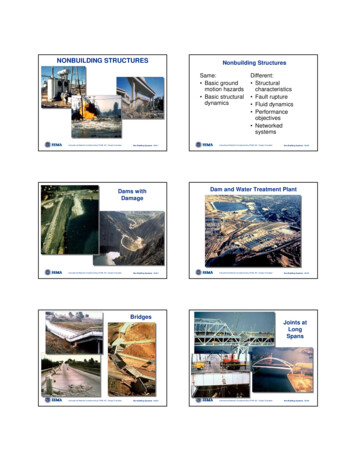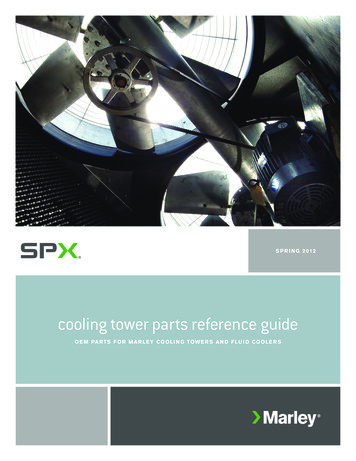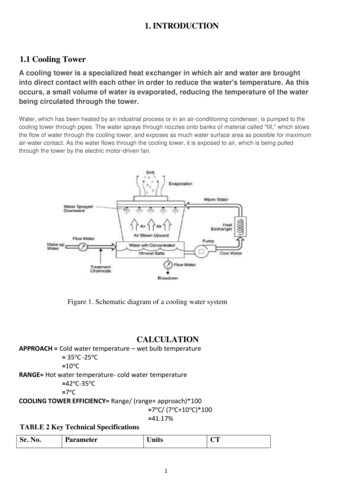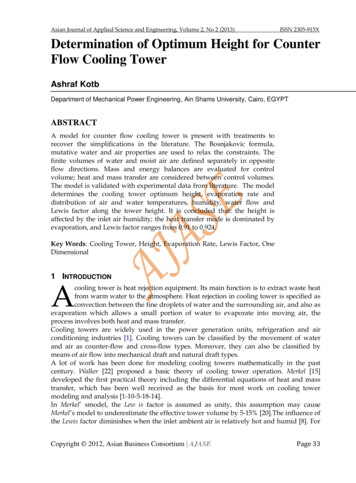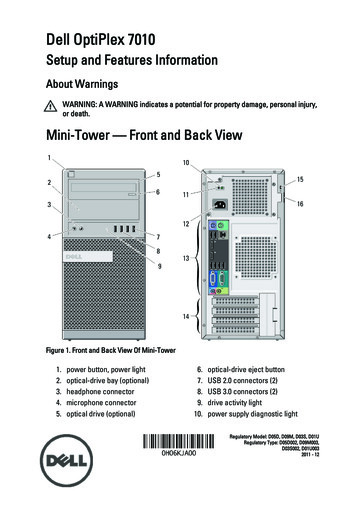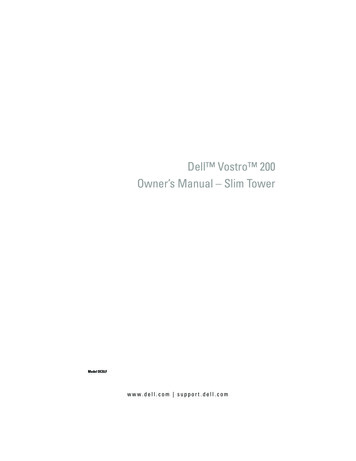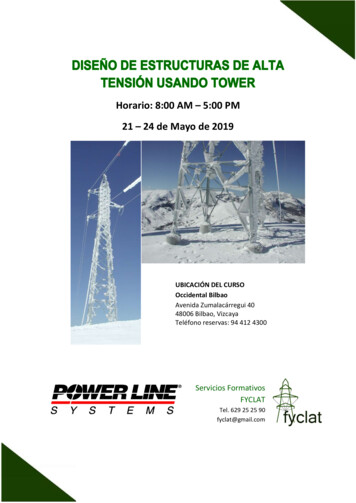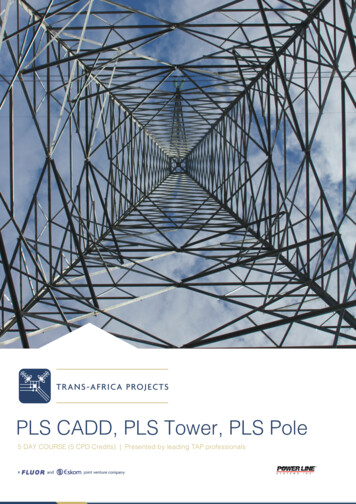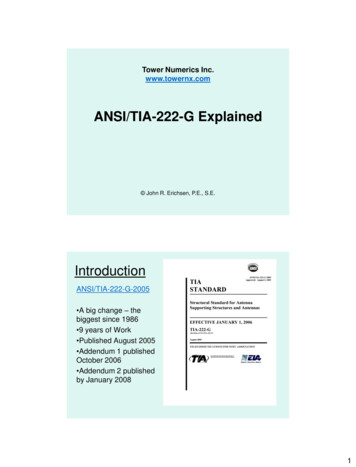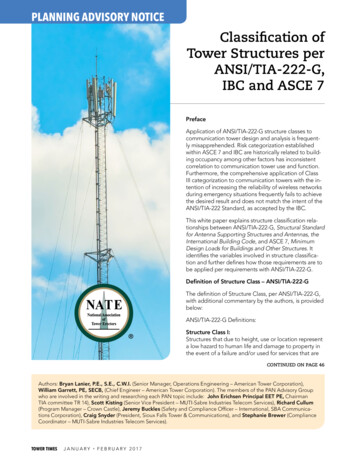
Transcription
PLANNING ADVISORY NOTICEClassification ofTower Structures perANSI/TIA-222-G,IBC and ASCE 7PrefaceApplication of ANSI/TIA-222-G structure classes tocommunication tower design and analysis is frequently misapprehended. Risk categorization establishedwithin ASCE 7 and IBC are historically related to building occupancy among other factors has inconsistentcorrelation to communication tower use and function.Furthermore, the comprehensive application of ClassIII categorization to communication towers with the intention of increasing the reliability of wireless networksduring emergency situations frequently fails to achievethe desired result and does not match the intent of theANSI/TIA-222 Standard, as accepted by the IBC.This white paper explains structure classification relationships between ANSI/TIA-222-G, Structural Standardfor Antenna Supporting Structures and Antennas, theInternational Building Code, and ASCE 7, MinimumDesign Loads for Buildings and Other Structures. Itidentifies the variables involved in structure classification and further defines how those requirements are tobe applied per requirements with ANSI/TIA-222-G.Definition of Structure Class – ANSI/TIA-222-GThe definition of Structure Class, per ANSI/TIA-222-G,with additional commentary by the authors, is providedbelow:ANSI/TIA-222-G Definitions:Structure Class I:Structures that due to height, use or location representa low hazard to human life and damage to property inthe event of a failure and/or used for services that areCONTINUED ON PAGE 46Authors: Bryan Lanier, P.E., S.E., C.W.I. (Senior Manager, Operations Engineering – American Tower Corporation),William Garrett, PE, SECB, (Chief Engineer – American Tower Corporation). The members of the PAN Advisory Groupwho are involved in the writing and researching each PAN topic include: John Erichsen Principal EET PE, ChairmanTIA committee TR 14), Scott Kisting (Senior Vice President – MUTI-Sabre Industries Telecom Services), Richard Cullum(Program Manager – Crown Castle), Jeremy Buckles (Safety and Compliance Officer – International, SBA Communications Corporation), Craig Snyder (President, Sioux Falls Tower & Communications), and Stephanie Brewer (ComplianceCoordinator – MUTI-Sabre Industries Telecom Services).TOWER TIMESJANUARY FEBRUARY 2017
PLANNING ADVISORY NOTICE (CONTINUED)optional and/or wherea delay in returning theservices would be acceptable.Section A.2.2 furtherdefines Class I structures:Structures used for services that are optional orwhere a delay in returning the services wouldbe acceptable such as:residential wireless andconventional two-wayradio communications;television, radio and scanner reception; wirelesscable; amateur and CBradio communications.exposure to more than a few individuals (e.g. Significant with respect to property means property surrounding the tower could be damaged or destroyed. Withrespect to reliability, the phrase “Used for services thatmay be provided by other means” signifies redundancyexists within the network to support temporary loss ofservice due to a specific site. This redundancy is present in almost all public wireless service, including E911networks.Nextel Cellsite in Cuiritiba,South of Brazil230 Ft (70M) triangularself-support towerCommentary: Failure ofPhotographer: Paulo Abreu,Seccional Brasil S/Athe structure defined asStructure Class I typicallyonly affects the owner, although services provided mayaffect other users. Human life is essentially not at riskand the public well-being is largely unaffected by thetower failure.Structure Class II:Structures that due toheight, use or location,represent a significanthazard to human life and/or damage to property inthe event of failure and/or used for services thatmay be provided by othermeans.ANSI/TIA-222-G, Addendum 2 Annex A SectionA.2.2 further defines ClassII structures based on reliability criteria: Structuresused for services that maybe provided by othermeans such as: commercial wireless communications; television and radiobroadcasting; cellular,PCS, CATV, and microwave communications.JANUARY ANSI/TIA-222-G, Addendum 2 Annex A SectionA.2.2 further defines ClassIII structures based on reliability criteria: Structuresused primarily for essential communications suchas civil or national defense, emergency, rescue,or disaster operations,military and navigationfacilities.Monopole with cloudEast St. Louis, IllionoisPhotographer: Steve Jones,US Tower Services, Inc.Commentary: With respect to reliability, Class III structures represent towers for which the owner/providercannot tolerate any loss of the network/signal, due toeither types of services provided or zero redundancy existing in the network. Beyond zero redundancy,failure could also potentially impact other services, suchas power, water, transportation, etc. that are consideredessential to human life. Finally, Structure Class III canbe quantified when a high risk to life/safety exists in theevent of a failure of the structure. The risk is exemplified when the public venue is not mobile (e.g. hospital,school, large public emergency gathering facility).Guy tower constructed byMercury Communications, Inc.Definition of Risk Category – ASCE 7-10 & IBCPhotographer: Trisha Fribis,Mercury Communications Inc.The ASCE 7 Standard, Minimum Design Loads forBuildings and Other Structures provides the basis forstructural load calculation for both TIA-222 and the International Building Code. The most recent publishededition is ASCE 7-10, which dictates classification ofbuildings and other structures by assignment of a RiskCategory. ASCE7-10 provides four Risk Categories (I,II, III, IV), with each higher number placing greater significance of risk to the public. The Risk Categories aregenerally based on the risk to human life, health, andCommentary: Failure of a structure defined as StructureClass II presents significant hazard to human life and/or property if a tower fails. Significant with respect tohuman life means failure of the structure could result ininjury or casualties, but it’s very limited in practicality orTOWER TIMESStructure Class III:Structures that due toheight, use or locationrepresent a substantialhazard to human life and/or damage to property inthe event of failure and/orused primarily for essential communications.FEBRUARY 2017
PLANNING ADVISORY NOTICE (CONTINUED)welfare associated with damage or failure by nature ofoccupancy or use. Once Risk Category is established,importance factors are to be applied based on ASCE7-10, Table 1.5-2. These importance factors are included in the derivation of design loads for flood, wind,snow, earthquake, and ice applied to the structureduring design and analysis. The different Risk Categories can be paraphrased/commented as follows:harm to the public extends well beyond the site of thefailure. Often remediation cannot be completed due tothe nature of the failure (e.g. nuclear facility). Failure ofthese structures also typically ensures failure of additional multiple systems critical to the public (e.g. lossof power results in loss of water and transportation).These structures can be considered as an essentialfacility.Risk Category I: Failure results in low hazard to thepublic.Previous versions of the ACSE-7 used a parametercalled Occupancy Category to define the appropriaterisk category of a building or other structure. Occupancy Category, as used within the building codes, relatesprimarily to issues associated with life, safety, and fireprotection across a number of building systems, likeelectrical, mechanical, etc. This use has caused someconfusion as Risk Category’s purpose is to appropriately derive the expected reoccurrence of environmentalloads (wind, earthquake, ice, etc.) and the risks associated with structural failure.Risk Category II: Structures that do not fall within RiskCategories I, III and IV.Risk Category III: Failure results in a substantial risk tothe public. These structures can be thought of as beingneeded during times of emergency (e.g. hospitals,police stations, water treatment facilities) or supportinglarge population centers (e.g. malls, schools). Failure,while creating significant problems to the public, canbe remediated. These structures can be considered asan essential facility.Risk Category IV: Failure results in substantial hazardto the public. Failure of these structures typically meansChapter 16 of the International Building Code addresses Risk Category within section 1604.5. The sectionis brief and relies on interpretation of the nature ofoccupancy in order to assign the appropriate risk cateCONTINUED ON NEXT PAGETOWER TIMESJANUARY FEBRUARY 2017
PLANNING ADVISORY NOTICE (CONTINUED)Standard. “Essential communications” are definedwithin ANSI/TIA-222-G Annex A, A.2.2 as structuresused primarily in support of civil or national defense,emergency, rescue or disaster operations, military andnavigation facilities. On occasion, interpretations havebeen made based on the terms “emergency” and“rescue” in the above definition as validation of ClassIBC recognizes that unique structures require specificIII requirements for wireless telecommunication towers,design and performance criteria. This criterion includesas the expectation is typical personal communicationunique application of risk categorization. Telecommuniuse of a mobile wireless device may be used duringcation and broadcast towers are specifically addressedan emergency or rescue event, thus mandating theas unique structures within IBC Chapter 35 Referencedneed for the higher classification. This is not the intentStandards and within Section 3108. Section 3108 statesof the Standard. To properly apply the correct Strucspecifically that telecommunication and broadcast towture Class per ANSI/TIA-222-G the term “primarily”ers shall be designed and constructed in accordancemust be defined and weighed against the number ofwith the provisions of ANSI/TIA-222.lives at risk, as well as purpose and redundancy of thestructure, wireless equipment installed, or the networkApplication of Structure Class to Towersdesign supported. “Primarily” within the definitionabove is used to define structures that support wirelessAppropriate application of Structure Class I is typicaltelecommunication systems with limited or zero redunly simple to evaluate and is rarely controversial. Thedancy and hence place large numbers of lives at risk inmisinterpretation primarily occurs with the misapplicathe event of a failure. It also defines structures whosetion of Structure Class III in place of Structure Class II.purpose for installation is to support wireless servicesANSI/TIA-222-G references the term “essential comused primarily by emergency service providers, military,munications” within Table 2-1 and A.2.2. This referencenavigational or mass transit. ANSI/TIA-222-G addressesis to establish a link between ASCE-7 and IBC Riskredundancy of in Table 2-1. The terminology “used forCategory III and IV “essential facility” criteria and strucservices that may be provided by other means” is theture classification definitionswithintheANSI/TIA-222-GStructure Classification per TIA-222-G in supportof IBC 2012 and ASCE 7-10gory for design and analysis. IBC risk categories closelyparallel ASCE 7-10. IBC further includes certain specificbuilding types, contents, and occupancies within its riskcategory definitions for the sake of direct examples.Wireless telecommunication towers are not listed within Class III or Class IV Risk Categories.Structure Classificationper TIA-222-G inSupport of IBC 2012and ASCE ce/DataWhat is theprimary serviceprovided by thetower structure?First RepsonderPolice/Fire/MedicalYesMilitary NationalDefensePower/WaterSystems SupportDoesredundancyexist within thecommunication system/network the towerstructure supports?NoClass ITowerStructureTOWER TIMESClass IITowerStructureJANUARY FEBRUARY 2017Class IIITowerStructurePublicTransportation/Mass TransitCommuincations
PLANNING ADVISORY NOTICE (CONTINUED)defined difference between essential communicationsor Class III structures with limited or zero redundancyand Class II structures that deliver inherent redundancy.ConclusionStructure Class definitions have been incorporatedinto the ANSI/TIA-222 Standard to provide accurateand reasonable classification of tower structures. TheIBC specifically recognizes the ANSI/TIA-222 Standardas the guideline for communication tower design andanalysis and fundamentally accepts the ANSI/TIA222 structure classification as the basis required fortelecommunication and broadcast towers. Use of theANSI/TIA-222-G definitions allows for more appropriateapplication of assessing risk, when considering factorslike public safety, service and network redundancy.Inherent redundancy exists in the vast majority of wireless tower supported networks, including networks thatsupport emergency services such as E911. Because ofthis redundancy, application of higher structure classes to individual towers typically has little effect on theresiliency of overall network performance. Although asignificant total of the population may be potentially (or“be” here) impacted by the loss of service of a wirelessprovider, the loss of an individual wireless site does notconsistently compromise the entire wireless network,nor eliminate the service provided in a specific location.Therefore, the potential impact to the public typicallyis actually very small, as opposed to what might initiallybe estimated.Higher structure classes may be warranted when thefailure of the tower implies significant physical consequences to the surrounding area, affects essential services, such as water, power, transportation, etc. or whenloss of specific wireless service at a location significantlycomprises the overall network or eliminates designatedemergency service in a specific geographic location.In effort to truly enhance the reliability of a wireless sitein these scenarios, strengthening of a
ANSI/TIA-222-G references the term “essential com-munications” within Table 2-1 and A.2.2. This reference is to establish a link between ASCE-7 and IBC Risk Category III and IV “essential facility” criteria and struc-ture classification definitions within the ANSI/TIA-222-G Standard. “Essential communications” are defined within ANSI/TIA-222-G Annex A, A.2.2 as structures used .
